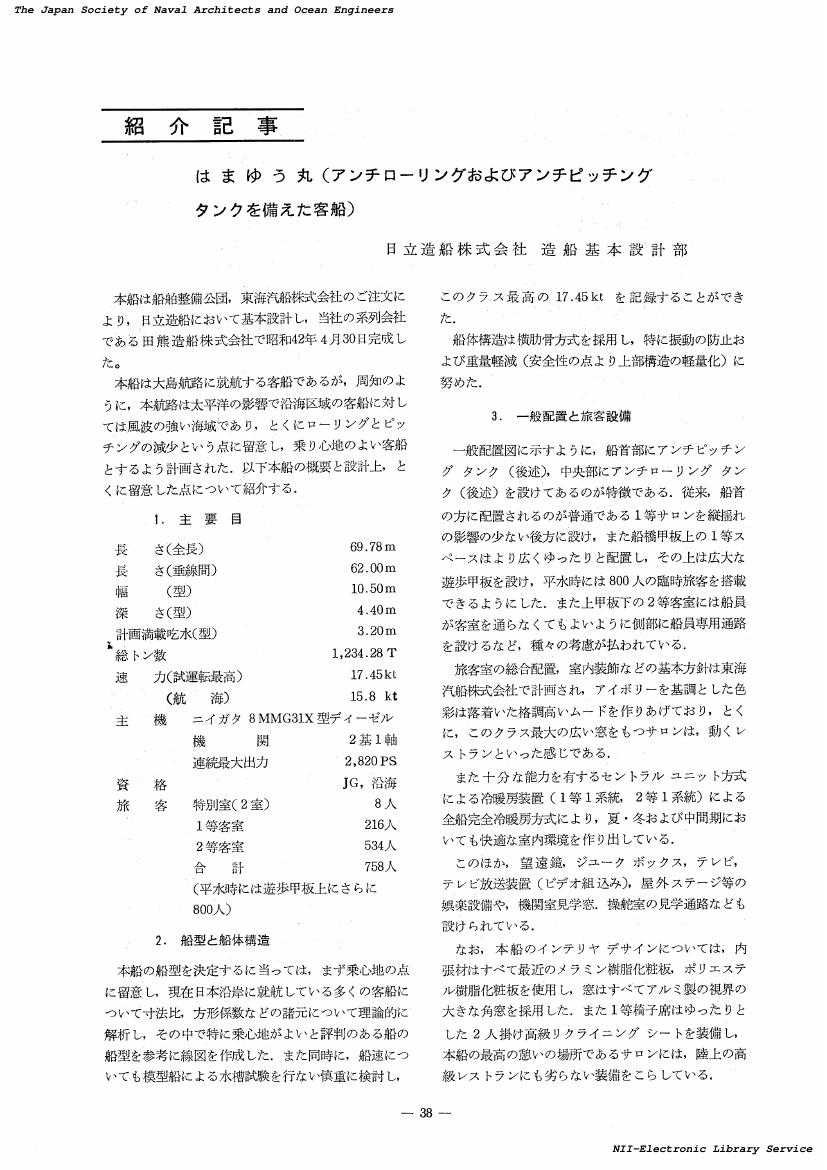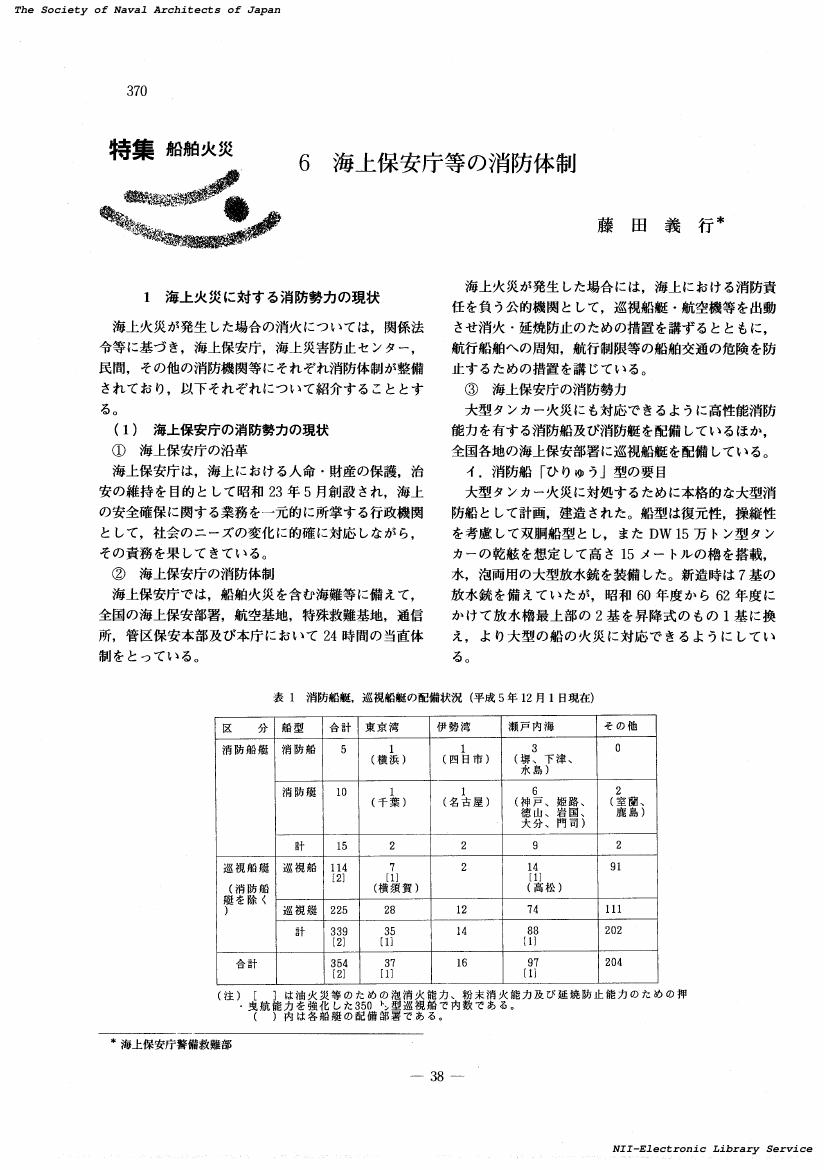1 0 0 0 OA 形状影響係数の一決定法
- 著者
- 岡畑 豪 藪下 和樹
- 出版者
- 公益社団法人 日本船舶海洋工学会
- 雑誌
- 日本船舶海洋工学会論文集 (ISSN:18803717)
- 巻号頁・発行日
- vol.26, pp.17-25, 2017 (Released:2018-03-03)
- 参考文献数
- 27
- 被引用文献数
- 2
We present a new method determining a form factor from resistance test results. The total resistance coefficient is approximated by a straight line and a polynomial expression in the present method. The straight line and the polynomial expression represent a viscous resistance and a wave-making resistance, respectively. It is shown that existing flat plate friction formulae are expressed as straight lines, and its inclination is only a function of the form factor. We determine the inclination (form factor) and coefficients of the polynomial expression by means of a linear least-squares method. The features of the present method are that: the form factor is decided without extrapolation; all measured data of resistance testing can be used in this analysis, although low-speed range data should be selected in the Prohaska's method. Using the ITTC57 correlation line, the values of the form factors obtained by the present method are almost the same as by Prohaska's method. It is found that the influence of the unreliable extra low-speed range data in the present method is less than in the Prohaska's method.
1 0 0 0 OA 1.2 具体例その1「へりおす」の引揚 : 1 サルベージ(<特集>大深度重作業技術)
- 著者
- 清水 信夫
- 出版者
- 公益社団法人 日本船舶海洋工学会
- 雑誌
- Techno marine 日本造船学会誌 (ISSN:09168699)
- 巻号頁・発行日
- vol.867, pp.267-271, 2002-05-10 (Released:2018-03-28)
- 参考文献数
- 1
1 0 0 0 OA 係留船に対する安全対策について
- 著者
- 久保田 秀夫 平原 祐
- 出版者
- 公益社団法人 日本船舶海洋工学会
- 雑誌
- 日本造船学会誌 (ISSN:03861597)
- 巻号頁・発行日
- vol.715, pp.28-35, 1989-01-25 (Released:2018-04-05)
1 0 0 0 OA 受賞作品紹介
- 出版者
- 公益社団法人 日本船舶海洋工学会
- 雑誌
- 日本船舶海洋工学会誌 KANRIN(咸臨) (ISSN:18803725)
- 巻号頁・発行日
- vol.61, pp.App5, 2015-07-10 (Released:2017-12-28)
1 0 0 0 OA はまゆう丸 : アンチローリングおよびアンチピッチングタンクを備えた客船
- 著者
- 日立造船株式会社造船基本設計部
- 出版者
- 公益社団法人 日本船舶海洋工学会
- 雑誌
- 関西造船協会誌 125 (ISSN:03899101)
- 巻号頁・発行日
- pp.38-43, 1967-06-30 (Released:2018-02-25)
- 著者
- 有馬 光孝
- 出版者
- 公益社団法人 日本船舶海洋工学会
- 雑誌
- Techno marine 日本造船学会誌 (ISSN:09168699)
- 巻号頁・発行日
- vol.836, pp.136-140, 1999
1 0 0 0 OA 群知能水中グライダーによる3 次元広域海洋観測手法の提案
- 著者
- 小畠 かな子 有馬 正和
- 出版者
- 公益社団法人 日本船舶海洋工学会
- 雑誌
- 日本船舶海洋工学会論文集 (ISSN:18803717)
- 巻号頁・発行日
- vol.34, pp.115-122, 2021 (Released:2022-02-28)
- 参考文献数
- 7
- 被引用文献数
- 1
The ocean absorbs heat and carbon dioxide from the atmosphere and serves to mitigate rapid climate change caused by human activities. The ocean also has the function of maintaining natural cycles such as the oceanic general circulation, carbon cycle and providing us with fishery resources. A healthy, pollution-free marine environment is essential for the sustainable development of human society. However, global warming, ocean acidification, oxygen depletion, and accumulation of marine plastic waste are now facing serious threats to marine ecosystems. In order to conserve the abundant sea, it is very important to have a correct understanding of the ocean environment and marine ecosystem conditions over a long term and wide area. In this research, the authors assume the underwater glider with independently controllable main wings, SOARER developed at Osaka Prefecture University, and propose a threedimensional wide-area ocean observation strategy for Japan's Exclusive Economic Zone (EEZ). Several cases of underwater cruise simulation with swarm intelligent autonomous underwater gliders were carried out to estimate the required number of underwater gliders which cover the Japan's EEZ and to consider its validity and effectiveness.
1 0 0 0 バーチャルボートレース : 運輸省船舶技術研究所一般公開において
- 著者
- 平田 信行 川村 隆文 牧野 雅彦 日野 孝則
- 出版者
- 公益社団法人 日本船舶海洋工学会
- 雑誌
- Techno marine 日本造船学会誌 (ISSN:09168699)
- 巻号頁・発行日
- vol.848, pp.124-127, 2000
- 参考文献数
- 2
- 被引用文献数
- 1
- 著者
- 北島 祥悟
- 出版者
- 公益社団法人 日本船舶海洋工学会
- 雑誌
- 日本船舶海洋工学会誌 KANRIN(咸臨) (ISSN:18803725)
- 巻号頁・発行日
- vol.58, pp.42-44, 2015
- 著者
- 北島 祥悟
- 出版者
- 公益社団法人 日本船舶海洋工学会
- 雑誌
- 日本船舶海洋工学会誌 KANRIN(咸臨) (ISSN:18803725)
- 巻号頁・発行日
- vol.42, pp.43-44, 2012
- 著者
- 三菱重工業株式会社神戸造船所設計部
- 出版者
- 公益社団法人 日本船舶海洋工学会
- 雑誌
- 関西造船協会誌 (ISSN:03899101)
- 巻号頁・発行日
- vol.181, pp.111-115, 1981
1 0 0 0 180t重荷役装置について
- 著者
- 杉山 董 小川 久 吉田 隆一
- 出版者
- 公益社団法人 日本船舶海洋工学会
- 雑誌
- 関西造船協会誌 (ISSN:03899101)
- 巻号頁・発行日
- vol.103, pp.1-10, 1961
This heavy derrick gear was installed in sister ships SHUNKOKU-MARU and SHUN-EI-MARU, completed in Kawasaki Dockyard Company in July and August, 1960, respectively. Both ships which are owned by Nihon Kisen K.K. and operated by Hinode Kisen K.K., having identical overall length of 132.480m and deadweight of 9,009t, were designed to load and carry extra-super-heavy cargoes, such as rolling stocks, barges, heavy machineries and etc. The most unique feature of the heavy derrick, which has the capacity of 180 tons, is the adoption of the so-called "2 hatch-1 derrick system", enabling one unit of heavy derrick to serve two cargo hatches. Adoption of this system realized decrease in weight of about 20% from the ordinary "1 hatch-1 derrick system". The gear consists of a tower mast installed on the ship center line of maximum diameter 3.600m, with a goose neck ring provided at its foot and with a 180 ton heavy derrick boom connected with the ring. Fall wire and topping lift wire, which are led inside of the tower mast, are wound by 35 ton steam driven heavy duty winches installed on both sides of the upper deck. A heavy derrick boom is capable of rotating about 320° from 70° swing out position at the forward starboard side to 70° swing out position at aft starboard side. In order to minimize the friction by rotation Of the goose neck ring, the ring is supported by 692 roller bearings. The results of 200 ton overload test carried out for the gear illustrated favorable agreement with the respective design values. Details, design and the test results of the gear are described below.
1 0 0 0 ディーゼル船機関部重量について
- 著者
- 井上 邦之助 近藤 秀一 今井 由次 仲田 武彦
- 出版者
- 公益社団法人 日本船舶海洋工学会
- 雑誌
- 関西造船協会誌 (ISSN:03899101)
- 巻号頁・発行日
- vol.96, pp.19-23, 1959
In the annexing table the relation is shown between P.S. and machinery weight investigated on 39 diesel driven vessels classified into three types, i.e., cargo vessels with electric deck auxiliaries, cargo vessels with steam deck auxiliaries and tankers. In each type of vessel, machinery weight is itemized into eight main sections: main engine, shaft & propeller, auxiliary machinery, boiler, funnel & uptake, piping, sundries and dynamo. Relation between weight percentage of each section and p.s. is indicated on graph. It is hoped that this investigation will be useful for basic design and cost estimation of vessel.
1 0 0 0 OA 海上保安庁等の消防体制
- 著者
- 藤田 義行
- 出版者
- 公益社団法人 日本船舶海洋工学会
- 雑誌
- Techno marine 日本造船学会誌 (ISSN:09168699)
- 巻号頁・発行日
- vol.779, pp.38-42, 1994 (Released:2018-02-25)
1 0 0 0 OA 浅水深海域における浮体式洋上風車のシンカー付きカテナリー係留に関する研究
- 著者
- 恩田 将維 和田 良太 尾崎 雅彦
- 出版者
- 公益社団法人 日本船舶海洋工学会
- 雑誌
- 日本船舶海洋工学会論文集 (ISSN:18803717)
- 巻号頁・発行日
- vol.32, pp.77-90, 2020 (Released:2021-04-02)
- 参考文献数
- 24
The purpose of this study is to investigate the feasibility of catenary chain mooring with sinker in the shallow waters of 50 to 100 meters depth facing the open ocean. Although the effect of the sinker can be expected to reduce the hardening nonlinearity of the catenary characteristics statically, it is necessary to consider the dynamic effects of sinkers ascending or sitting off the sea floor. As the procedure, we set the environmental design conditions assuming the coastal area of Japan and the semi-submersible type floating offshore wind turbine model, and perform static analysis to investigate the effect of parameters on the mooring characteristics, and then dynamic analysis to judge the strength feasibility of the mooring chains in storm conditions. Catenary theory is applied to the static analysis, and OrcaFlex is used for dynamic analysis to consider the interaction between the floating body, mooring system and sea floor in time domain. The pros and cons of using sinker in “Catenary chain with intermediate sinker type” and “Catenary with Hinged Arm Sinker Mooring type” are discussed to clarify the design considerations.
- 著者
- 永田 幸伸 福留 邦繁 後藤 浩二
- 出版者
- 公益社団法人 日本船舶海洋工学会
- 雑誌
- 日本船舶海洋工学会講演会論文集
- 巻号頁・発行日
- vol.7, pp.55-58, 2008
1 0 0 0 ふぇにっくす丸について
- 著者
- 関西汽船株式会社工務部
- 出版者
- 公益社団法人 日本船舶海洋工学会
- 雑誌
- 関西造船協会誌 (ISSN:03899101)
- 巻号頁・発行日
- vol.105, pp.46-54, 1962
1 0 0 0 帰省ラッシュの怪!?
- 出版者
- 公益社団法人 日本船舶海洋工学会
- 雑誌
- らん:纜 (ISSN:09160981)
- 巻号頁・発行日
- vol.37, 1997
1 0 0 0 OA 深層強化学習に基づく自動ネスティング手法
- 著者
- 谷口 智之 平方 勝 万 順一
- 出版者
- 公益社団法人 日本船舶海洋工学会
- 雑誌
- 日本船舶海洋工学会論文集 (ISSN:18803717)
- 巻号頁・発行日
- vol.33, pp.209-217, 2021 (Released:2021-08-31)
- 参考文献数
- 18
An automatic nesting algorithm based on deep reinforcement learning for shipbuilding is proposed. Automatic nesting method is desired because of the large number of parts to be placed. The nesting problem in shipbuilding is very difficult because of the relatively small area where they can be placed and the variety of shapes that can rotate freely. Since it is very difficult to manually create effective placement rules, this paper proposes an algorithm to generate rules autonomously based on reinforcement learning. To apply reinforcement learning to the nesting problem, we organized the problem as a Markov chain process. Based on deep q network, a type of reinforcement learning, we used the components of a real ship's block to learn the network parameters. The parts are represented in pixel format. It is confirmed that the present method was superior to the conventional method, and the results were comparable to those of a skilled person. However, for unlearned members, the results are inferior to those of the conventional method. This problem can be solved by relearning including unlearned components.
- 著者
- 梶谷 尚
- 出版者
- 公益社団法人 日本船舶海洋工学会
- 雑誌
- Techno marine 日本造船学会誌 (ISSN:09168699)
- 巻号頁・発行日
- vol.759, pp.702-706, 1992




